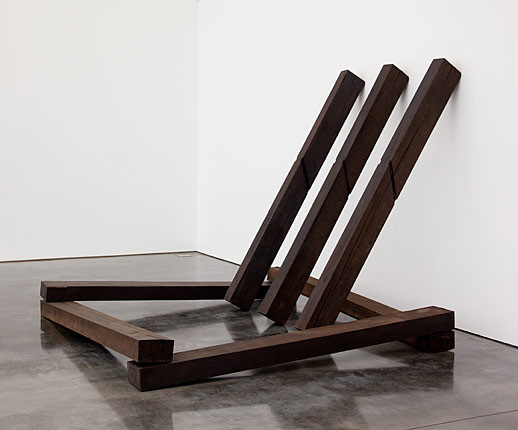Mono-ha
22 Jun - 03 Aug 2012

Mono-ha
Noboru Takayama, Underground Zero (Part), 1969/2003 Railroad ties; light bulb; seven ties: 100 x 5 x 9 inches (254 x 13.3 x 22.9 cm); 89 x 100 x 113 inches (226.1 x 254 x 287 cm) overall installed
Noboru Takayama, Underground Zero (Part), 1969/2003 Railroad ties; light bulb; seven ties: 100 x 5 x 9 inches (254 x 13.3 x 22.9 cm); 89 x 100 x 113 inches (226.1 x 254 x 287 cm) overall installed
MONO-HA
Requiem for the Sun
Curated by Mika Yoshitake
22 June - 3 August 2012
Gladstone Gallery is pleased to announce its forthcoming exhibition Requiem for the Sun: The Art of Mono-ha, organized in collaboration with Blum & Poe, Los Angeles. This exhibition examines the postwar Japanese artistic phenomenon Mono-ha (School of Things). Representing a key art historical turning point, “Requiem for the Sun" refers to the death of the sun as emblematic of the loss of symbolic expression and permanence immanent to the object in Japanese postwar art practice. Included in the exhibition are works by Koji Enokura (1942-1995), Susumu Koshimizu (1944- ), Nobuo Sekine (1942- ), Kishio Suga (1944- ), Jiro Takamatsu (1936-1998), Noboru Takayama (1944- ), Lee Ufan (1936- ), and Katsuro Yoshida (1943-1999).
Mono-ha's primary tenet explores the encounter between natural and industrial objects, such as glass, stones, steel plates, wood, cotton, light bulbs, leather, oil, wire and Japanese paper, in and of themselves arranged directly on the floor or in an outdoor field. Evident in their works is a tendency based not on the art historical recuperation of objects, but on maintaining an affective relationship between works and our surrounding environment. That is, the works operate as a process of perceiving a perpetually passing present that opens the materiality of the work beyond what is simply seen. These practices are linked to the cultural milieu of process and post-minimalist art apparent on an international level during the 1960s and 1970s. What distinguishes their work is the refined technique of repetition as a studied production of difference developed over time in each artist's practice.
The exhibition will show select key installations, works on paper, and photographs that reveal resonant concepts and artistic methods relative to the exhibition. Some themes include perceiving works as actions or events, experiments in topology and spatial continuity, visceral materiality, and the contingency of the body. While the art of Mono-ha has been the subject of exhibitions in Asia and Europe, it is virtually unknown in North America. Requiem for the Sun: The Art of Mono-ha will provide a critical introduction to this extremely significant work.
Requiem for the Sun
Curated by Mika Yoshitake
22 June - 3 August 2012
Gladstone Gallery is pleased to announce its forthcoming exhibition Requiem for the Sun: The Art of Mono-ha, organized in collaboration with Blum & Poe, Los Angeles. This exhibition examines the postwar Japanese artistic phenomenon Mono-ha (School of Things). Representing a key art historical turning point, “Requiem for the Sun" refers to the death of the sun as emblematic of the loss of symbolic expression and permanence immanent to the object in Japanese postwar art practice. Included in the exhibition are works by Koji Enokura (1942-1995), Susumu Koshimizu (1944- ), Nobuo Sekine (1942- ), Kishio Suga (1944- ), Jiro Takamatsu (1936-1998), Noboru Takayama (1944- ), Lee Ufan (1936- ), and Katsuro Yoshida (1943-1999).
Mono-ha's primary tenet explores the encounter between natural and industrial objects, such as glass, stones, steel plates, wood, cotton, light bulbs, leather, oil, wire and Japanese paper, in and of themselves arranged directly on the floor or in an outdoor field. Evident in their works is a tendency based not on the art historical recuperation of objects, but on maintaining an affective relationship between works and our surrounding environment. That is, the works operate as a process of perceiving a perpetually passing present that opens the materiality of the work beyond what is simply seen. These practices are linked to the cultural milieu of process and post-minimalist art apparent on an international level during the 1960s and 1970s. What distinguishes their work is the refined technique of repetition as a studied production of difference developed over time in each artist's practice.
The exhibition will show select key installations, works on paper, and photographs that reveal resonant concepts and artistic methods relative to the exhibition. Some themes include perceiving works as actions or events, experiments in topology and spatial continuity, visceral materiality, and the contingency of the body. While the art of Mono-ha has been the subject of exhibitions in Asia and Europe, it is virtually unknown in North America. Requiem for the Sun: The Art of Mono-ha will provide a critical introduction to this extremely significant work.
